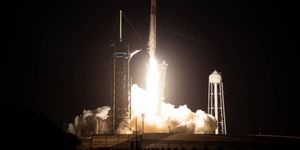NASA's Innovative Space Communications: ILLUMA-T and LCRD
When the 29th SpaceX Commercial Resupply Services mission to the International Space Station (ISS) launches later this year, currently scheduled for November 1, it will carry the Integrated LCRD Low Earth Orbit User Modem and Amplifier Terminal (ILLUMA-T) to the orbiting outpost, along with a myriad of other scientific experiments and supplies. The purpose of ILLUMA-T is to work in tandem with the Laser Communications Relay Demonstration (LCRD), which launched to geosynchronous orbit—approximately 22,000 miles from Earth—onboard an Atlas V 551 in December 2021, to finish the first end-to-end, two-way laser relay system developed by NASA.
“Laser communications offer missions more flexibility and an expedited way to get data back from space,” said Badri Younes, who is the former deputy associate administrator for NASA's Space Communications and Navigation (SCaN) program. “We are integrating this technology on demonstrations near Earth, at the Moon, and in deep space.”
The purpose of NASA’s SCaN program office is to display the potential for using laser communications from the ISS to Earth, which could hold the potential for its use on future crewed deep space missions, as well. As noted, LCRD has been in orbit since December 2021, and has been demonstrating its laser communications capabilities by beaming data back and forth between Earth-based stations and has been carrying out experiments prior to the launch of ILLUMA-T.
“Once ILLUMA-T is on the space station, the terminal will send high-resolution data, including pictures and videos to LCRD at a rate of 1.2 gigabits-per-second,” said Matt Magsamen, who is the deputy project manager for ILLUMA-T. “Then, the data will be sent from LCRD to ground stations in Hawaii and California. This demonstration will show how laser communications can benefit missions in low Earth orbit.”
Currently, data is transmitted via conventional radio frequency systems, but the combination of ILLUMA-T and LCRD hopes to be an accessory to traditional communications systems, as opposed to replacing them entirely. As noted, the development of laser communication technology will only broaden the scope of technological capabilities for future deep space crewed missions, specifically to the Moon, and possibly Mars.
How will ILLUMA-T and LCRD help improve laser communication technologies in the coming years and decades? Only time will tell, and this is why we science!
As always, keep doing science & keep looking up!








